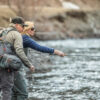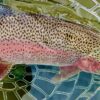“I didn’t know it, but a radical change had taken place in my life. I had become a fisherman and would never be quite the same again.” ~Jack Hemingway
With the air and water cooling down, the leaves starting to change color and fall, and with the traditional celebrations of summer coming to a head, it is time to let yourself be a fisherman again. These are the best months to rediscover why you love this sport so much. And if you are new to fly fishing, this is a great time to let the radical transformation occur and forever call yourself a fly fisherman.
SILVER CREEK
While there is still some late morning action with the few Tricos remaining along with some Baetis, the real action has shifted to the Callibaetis in the afternoon. This bug is smaller than the early season Callibaetis, so you will need to have plenty of size 18 and 20s in all phases of this insects life cycle (nymphs, emergers, duns and spinners). To find the Callibaetis, search the sloughs and slow water stretches of the upper and lower Kilpatrick’s Pond. The fly is easily identified by its rhythmic bouncing just above the water as it prepares to lay its eggs. On windy days, try a size 16 or 18 Hackle Stackers along with a Quigley Cripple or the Callibaetis Floating Nymph. When the water is still, try Harrop’s Partridge Spinner or Harrop’s Cutwing Dun in a size 18. Also watch the weather forecast over the next few weeks as cloudy, cool days will trigger fantastic Baetis hatches. These Baetis are small and you will need patterns in size 20, 22, and 24 to match the hatch. For this bug, size is more important than color and fish should take any well presented fly. Also, be prepared for some Mahogany Duns as they will make an appearance in the coming weeks.
THE BIG WOOD
The Wood has survived another blow out last week and is already clearing up. The river may still have a bit of color below Warm Springs for a few more days. Despite this the fishing has been very good. With the low water it is important that you approach the water carefully and scan the water for feeders in the shallows. Often the largest fish hold in the least likely water and these fish can be spooky. For dries, I recommend using small Gulper Specials (18) with orange posts which show up nicely in the glare and light chop of riffles. Also, a few Red Quills have been spotted in the South Valley and should make their way up river as we head into cooler temperatures in the weeks to come. Terrestrials have also been a good bet, especially hoppers and flying ants. Trailing a small size 16 or 18 Zebra Midge in red or black, a pheasant tail, Bishop’s Dynamite, or Rainbow Warrior can also be effective during slow periods. Also, Euro Nymphing is a great way to turn those missed takes into hookups. For a change of pace, try Euro Nymphing with a Japanese Tenkara Rod!
SOUTH FORK OF THE BOISE
With the lower flows (600 CFS), the river is completely accessible to wade anglers and still floatable from Village to Indian Rock. Hoppers have been turning fish, but the main action is in the afternoon on Pinks. You will need to scan the water carefully looking for this bug and any fish feeding on it. Be sure to have both dun and emerger patterns to fool these picky fish. Nymphing can fill in the periods before and after the Pink hatch; try large rubber leg stone flies, caddis, and midge patterns.
LOCAL PONDS
Lake Creek, Penny Lake, or Gaver’s Lagoon have been stocked over the summer and are a great opportunity to introduce neophytes to fishing of any kind. Drop on by before you go and we will make sure you have the right gear, flies, or bait to be successful.
SALMON RIVER
The water is low on the Salmon opening up a lot of great walk and wade opportunities around the Stanley area. We are still offering float trips on the lower reaches of the river as well, but don’t be surprised if you need to exit the boat to push it through some shallow riffles. Still, floating is a great way to cover water and find some great late summer angling opportunities. Along the wooded stretches of the river, look for a few Spruce Moths to be fluttering about. Whether you see them or not, try using a tan caddis or stone fly in size 14 to 8 trailed by a smaller beaded nymph like a Pheasant Tail or a Bishop’s Dynamite along the banks or in the shallow riffles above the deeper runs. Swinging black, brown, and olive streamers or buggers can also be productive and you might even find a resident Bull trout.
BIG LOST BELOW MACKAY
The flows are dropping fast. Today they are at 300 CFS, down from 400, and tomorrow they might be even lower. Once the flows stabilize, the fishing is going to be really good. Expect the Trico and Baetis hatches to remain strong. In fact, at the new lower flows this could be the best dry fly action of the year on the Lost! Take a good number of House of Harrop Baetis and Tricos in size 20 to 24 and with the cooler temps expect the hatch and spinner fall to move to the middle of the day into the afternoon. Nymphing is always effective and with lower flows, sight nymphing with a single small Pheasant Tail, Zebra midge, or small Baetis nymph can be fun and effective. You might also try a standard dry dropper rigs or Euro Style techniques with a Rainbow Warrior, Iron Lotus, or Bishop’s Dynamite.
UPPER LOST- COPPER BASIN
This is a good option if you like to fish in an area for its scenery and solitude. The fall colors have come early to the Upper Lost! The fish count is down from previous years and on top of that, they can be spooky with the lower than average flows. Still, if you cover lots of water you will find some fine cutthroat trout and mountain whitefish in the deeper runs. Keep in mind, the trout will give you one chance, so make your first presentation count. Otherwise, be prepared to walk a long ways to the next fishy spot. For searching, try a Para Hopper, a flying ant, or an Elk Hair Caddis in size 14, 12 or 10 with a small trailing Zebra Midge, Bishop’s Dynamite, or Rainbow Warrior. If you find some feeders, use small size 18 parachute patterns, a long leader, and fine tippet.
|
Big Wood Big Lost Silver Creek Copper Basin South Fork of the Boise |
126 cfs 321 cfs 63 cfs 34 cfs 611 cfs |




